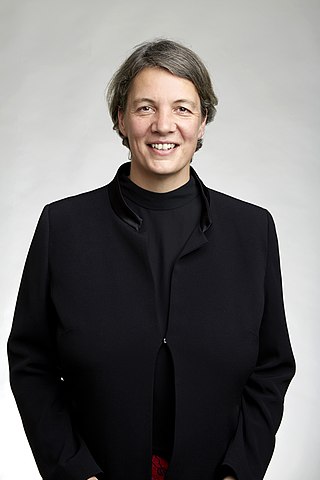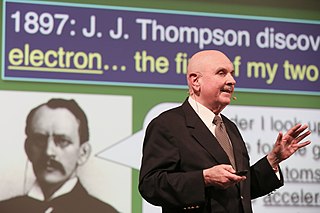Related Research Articles
In condensed matter physics and materials science, an amorphous solid is a solid that lacks the long-range order that is characteristic of a crystal. The terms "glass" and "glassy solid" are sometimes used synonymously with amorphous solid; however, these terms refer specifically to amorphous materials that undergo a glass transition. Examples of amorphous solids include glasses, metallic glasses, and certain types of plastics and polymers.

Silane (Silicane) is an inorganic compound with chemical formula SiH4. It is a colourless, pyrophoric, toxic gas with a sharp, repulsive, pungent smell, somewhat similar to that of acetic acid. Silane is of practical interest as a precursor to elemental silicon. Silane with alkyl groups are effective water repellents for mineral surfaces such as concrete and masonry. Silanes with both organic and inorganic attachments are used as coupling agents. They are commonly used to apply coatings to surfaces or as an adhesion promoter.

David Jonathan Gross is an American theoretical physicist and string theorist. Along with Frank Wilczek and David Politzer, he was awarded the 2004 Nobel Prize in Physics for their discovery of asymptotic freedom. Gross is the Chancellor's Chair Professor of Theoretical Physics at the Kavli Institute for Theoretical Physics (KITP) of the University of California, Santa Barbara (UCSB), and was formerly the KITP director and holder of their Frederick W. Gluck Chair in Theoretical Physics. He is also a faculty member in the UCSB Physics Department and is affiliated with the Institute for Quantum Studies at Chapman University in California. He is a foreign member of the Chinese Academy of Sciences.

Katharine Ellen Sykes is a British physicist, broadcaster and Professor of Sciences and Society at the University of Bristol. She was previously Collier Professor of Public Engagement in Science and Engineering, from 2002 to 2006. She has presented various BBC2 and Open University TV series, including Rough Science, Ever Wondered about Food, Alternative Therapies. Alternative Medicine and presented for the documentary television miniseries Brave New World with Stephen Hawking in 2011.

Karen L. Kavanagh is a professor of physics at Simon Fraser University in Burnaby, British Columbia, Canada, where she heads the Kavanagh Lab, a research lab working on semiconductor nanoscience.
In materials science, paracrystalline materials are defined as having short- and medium-range ordering in their lattice but lacking crystal-like long-range ordering at least in one direction.
Silicon monoxide is the chemical compound with the formula SiO where silicon is present in the oxidation state +2. In the vapour phase, it is a diatomic molecule. It has been detected in stellar objects and has been described as the most common oxide of silicon in the universe.

Crystalline silicon or (c-Si) Is the crystalline forms of silicon, either polycrystalline silicon, or monocrystalline silicon. Crystalline silicon is the dominant semiconducting material used in photovoltaic technology for the production of solar cells. These cells are assembled into solar panels as part of a photovoltaic system to generate solar power from sunlight.

Wahid Shams-Kolahi is a scientist and an electrical engineer who is known for his research in photovoltaic-related technologies.

Binary compounds of silicon are binary chemical compounds containing silicon and one other chemical element. Technically the term silicide is reserved for any compounds containing silicon bonded to a more electropositive element. Binary silicon compounds can be grouped into several classes. Saltlike silicides are formed with the electropositive s-block metals. Covalent silicides and silicon compounds occur with hydrogen and the elements in groups 10 to 17.

Michelle Yvonne Simmons is an Australian quantum physicist, recognised for her foundational contributions to the field of atomic electronics.
Low-temperature polycrystalline silicon (LTPS) is polycrystalline silicon that has been synthesized at relatively low temperatures compared to in traditional methods. LTPS is important for display industries, since the use of large glass panels prohibits exposure to deformative high temperatures. More specifically, the use of polycrystalline silicon in thin-film transistors (LTPS-TFT) has high potential for large-scale production of electronic devices like flat panel LCD displays or image sensors.
Mercedes Vila Juárez is a Spanish material science researcher. She is the chief technology officer (CTO) and co-founder of BioTech Foods SL.
Michael S. Fuhrer is a US/Australian physicist recognised internationally as a pioneer in atomically-thin (two-dimensional) materials, including graphene and novel topological materials, with expertise in fabrication and characterisation of their electronic and optical properties.
Xu Jianbin is the Choh-Ming Li Professor of Electronic Engineering and director of the material research center at The Chinese University of Hong Kong (CUHK). He is also a Distinguished Research Fellow at the Shenzhen Institutes of Advanced Technology, one of the Chinese Academy of Sciences.
Leonid A. Sazanov is a professor at the Institute of Science and Technology Austria (ISTA). Sazanov research explores the structure and function of large membrane protein complexes from the domain of bioenergetics. These molecular machines interconvert redox energy and proton motive force across biological membranes using a variety of mechanisms.

Giorgio Margaritondo is a Swiss and American physicist and an emeritus professor at École Polytechnique Fédérale de Lausanne (EPFL). He is known for his pioneering work in the use and dissemination of synchrotron radiation and free electron lasers.
Joanne Etheridge is an Australian physicist. She is Director of the Monash Centre for Electron Microscopy and Professor in the Department of Materials Science and Engineering at Monash University.
Joanne Whittaker is a marine geophysicist, from the Institute for Marine and Antarctic Studies at the University of Tasmania, who was awarded the Dorothy Hill award in 2017, and a L'Oreal Women in Science Fellowship in 2013. Her research contributes to understanding the structure and evolution of the Earth.
Valeria Paula Molinero is an Argentinian physicist who is the Jack and Peg Simons Endowed Professor of Theoretical Chemistry at the University of Utah. Her research investigates the simulation of the behavior of materials. She was awarded the American Physical Society Irving Langmuir Award in Chemical Physics in 2023.
References
- ↑ "Joanna Batstone FTSE". ATSE. Retrieved 11 October 2023.
- ↑ "Joanna Batstone". Monash University. Retrieved 11 October 2023.
- ↑ "ORCID". orcid.org. Retrieved 11 October 2023.
- ↑ STA-admin (25 October 2016). "Science meets Business - Breaking the barrier between science and business". Science and Technology Australia. Retrieved 11 October 2023.
- ↑ "Seminars & conferences | Management & Governance - UNSW Sydney". UNSW Sites. Retrieved 11 October 2023.
- ↑ Bristol, University of. "Joanna Batstone". www.bristol.ac.uk. Retrieved 11 October 2023.
- ↑ "Monash at the UN's AI for Good global summit". India Education | Latest Education News | Global Educational News | Recent Educational News. 7 July 2023. Retrieved 11 October 2023.
- ↑ Reidy, Madison (19 August 2017). "Artificial intelligence making skin cancer detection easier, more efficient". Stuff. Retrieved 11 October 2023.
- ↑ "Aussies supportive, but sketchy, about role of AI in society". IT Brief Australia. Retrieved 11 October 2023.
- ↑ "Silicide Formation". pubs.aip.org. doi:10.1063/1.353446 . Retrieved 11 October 2023.
- ↑ Hayzelden, C.; Batstone, J. L. (1 December 1993). "High Resolution In Situ TEM Studies of Silicide-Mediated Crystallization of Amorphous Silicon". MRS Online Proceedings Library. 321 (1): 579–584. doi:10.1557/PROC-321-579. ISSN 1946-4274.
- ↑ Batstone, J. L.; Tischler, M. A.; Collins, R. T. (24 May 1993). "Stability of visible luminescence from porous silicon". Applied Physics Letters. 62 (21): 2667–2669. doi:10.1063/1.109279. ISSN 0003-6951.
- ↑ Bristol, University of. "Joanna Batstone". www.bristol.ac.uk. Retrieved 11 October 2023.
- ↑ "Awards & Scholarships". Microscopy Society of America. Archived from the original on 30 August 2023. Retrieved 17 October 2023.
- ↑ "Prof. Joanna Batstone | Optimal Ageing Centre". 6 October 2022. Retrieved 11 October 2023.